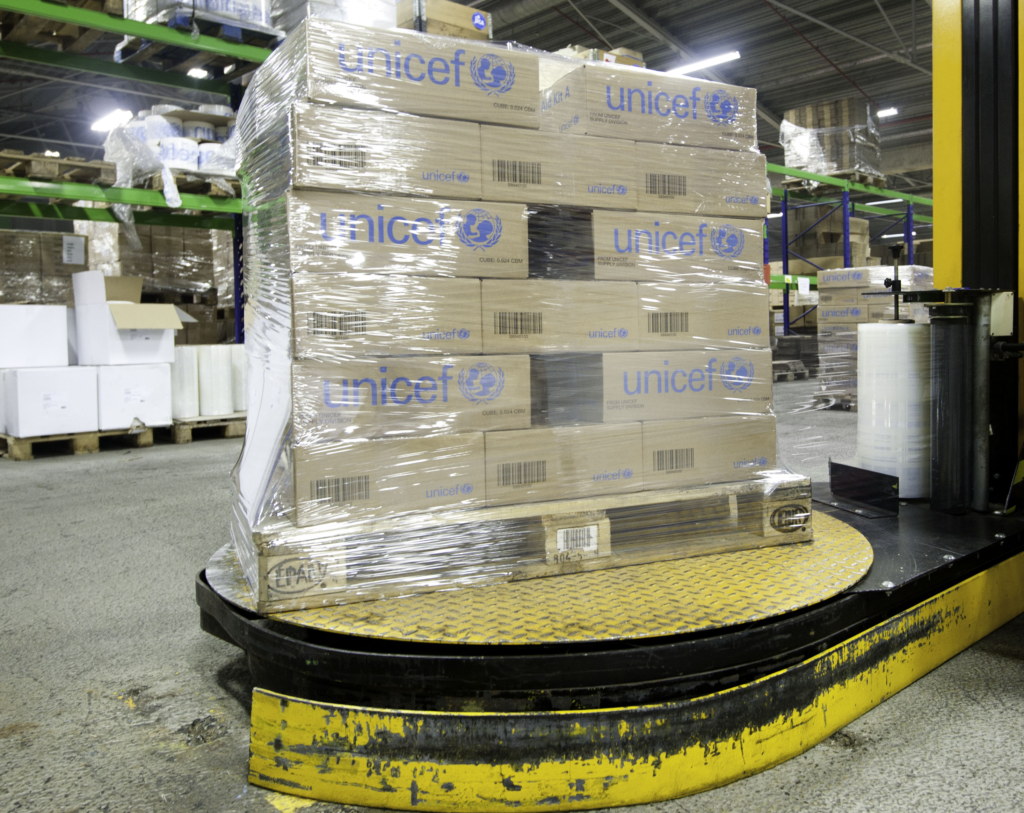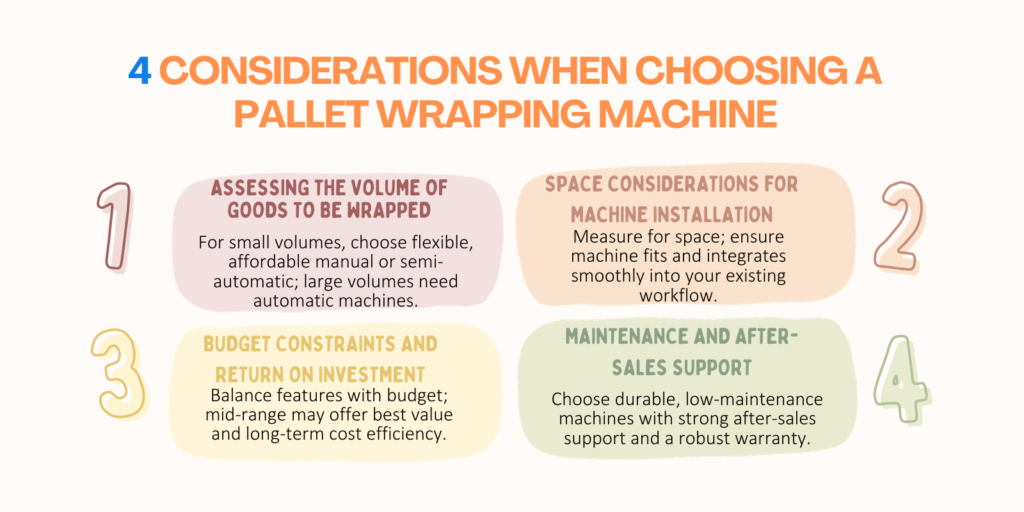In the fast-paced world of logistics and transportation, how do businesses ensure that their products reach their destination safely and intact? The challenge of protecting goods during transit is a significant one. Damages can lead to financial losses, unsatisfied customers, and tarnished reputations. The solution? A machine designed specifically to address this issue is the pallet wrapping machine.
Pallet-wrapping machines play a pivotal role in the packaging industry. They provide a protective layer around goods, ensuring they remain stable and shielded from external factors during transportation. By wrapping products efficiently and consistently, these machines guarantee the safety of items and offer peace of mind to businesses and their customers. As you delve deeper into this article, you’ll discover the intricate functions of this essential equipment and why it’s a game-changer in the world of packaging.
What is a Pallet Wrapping Machine?

A pallet wrapping machine is a specialized equipment designed to wrap goods stacked on a pallet with a protective film. This wrapping process ensures that the goods are secured, protected from external elements, and ready for transportation or storage. The machine uses a continuous roll of stretch or shrink film, wrapping it around the palletized goods consistently and uniformly. This safeguards the products and enhances the overall appearance, making them more presentable to clients or customers.
3 Types of Pallet Wrapping Machines
Over the years, I’ve worked with various models and types of pallet-wrapping machines. Here’s a brief overview:
- Manual Pallet Wrapping Machines: These are the most basic forms, requiring an operator to move the film around the pallet manually. While cost-effective, they can be labor-intensive and might not suit businesses with high volumes of goods to wrap.
- Semi-Automatic Pallet Wrapping Machines: A step up from the manual machines requires an operator to place the pallet and initiate the wrapping process. The machine then takes over, rotating the pallet and applying the film. It offers a balance between manual control and automation.
- Automatic Pallet Wrapping Machines: The pinnacle of efficiency, these machines are fully automated. Once the pallet is placed, the machine handles the entire wrapping process, from start to finish, without any human intervention. Ideal for businesses with large-scale operations, they ensure consistency and speed.

The Primary Functions of a Pallet Wrapping Machine
Navigating the complexities of the packaging world has taught me the importance of every piece of equipment. Among them, the pallet wrapping machine stands out for its utility and the myriad of functions it serves. Let’s delve into this machine’s primary roles in ensuring goods are perfectly packaged.
Protection
One of the foremost concerns in packaging is ensuring the safety of goods from various external factors. The pallet wrapping machine excels in this:
- Guarding Against External Elements: The protective film acts as a barrier, shielding goods from dust, moisture, and other contaminants. This is especially crucial for products sensitive to environmental conditions.
- UV Protection: For goods stored outdoors, the threat of UV rays can be detrimental. Certain wrapping films come with UV protection, ensuring that the sun’s harmful rays don’t compromise products.
Stabilization
Transportation can be rough, and the last thing any business wants is for their products to be damaged in transit:
- Securing Goods in Place: The machine wraps goods tightly, ensuring they remain stable and anchored to the pallet, even during turbulent journeys.
- Preventing Shifting and Falling: A well-wrapped pallet minimizes the risk of products shifting or toppling over, a common concern during transportation.
Tamper Evidence
In today’s world, ensuring the integrity of products is paramount:
- Detecting Tampering: The wrapping serves as a seal. If tampered with, it becomes evident, allowing businesses and consumers to identify potential breaches in product integrity.
- Guaranteeing Product Integrity: A securely wrapped pallet ensures that the product inside remains untouched and in its original condition upon arrival.
Cost-Efficiency
Efficiency isn’t just about speed; it’s about optimizing resources:
- Labor Savings: Automating the wrapping process reduces the need for manual labor, allowing staff to focus on other essential tasks.
- Material Optimization: The machine ensures consistent wrapping, which means less film is wasted. Over time, this can lead to significant material and cost savings.
4 Benefits of Using a Pallet Wrapping Machine
Throughout my tenure in the packaging sector, I’ve witnessed businesses transform their operations by making strategic equipment choices. The pallet wrapping machine, in particular, has consistently proven its worth. Here are some of the standout benefits I’ve observed when businesses incorporate this machine into their workflow:

Efficiency
Time is of essence in any industry, and the packaging sector is no exception:
- Speedy Operations: The machine’s automated process ensures that pallets are wrapped much faster than traditional manual methods. This speed translates to quicker turnaround times and the ability to easily handle larger volumes.
Safety
The well-being of staff is paramount, and the right tools can make a significant difference:
- Minimized Risk: Manual wrapping can be strenuous and poses risks of strains or injuries. By automating this task, the machine significantly reduces the chances of workplace accidents, ensuring a safer environment for employees.
Consistency
In the world of packaging, consistency is key to maintaining a brand reputation:
- Uniform Packaging: The machine ensures that every pallet is wrapped consistently. This uniform looks professional and guarantees that each product is packaged to the same high standard, regardless of volume.
Savings
Every business aims to optimize its operations for cost-effectiveness:
- Optimized Material Use: The machine’s precision ensures that there’s minimal wastage of wrapping material. Over time, this can lead to substantial savings.
- Labor Cost Reduction: With the machine handling the bulk of the wrapping process, businesses can allocate manpower to other critical areas, leading to more efficient labor utilization and potential cost reductions.
How Does a Pallet Wrapping Machine Work?

Having spent a significant portion of my career interacting with and understanding packaging machinery, I’ve often been asked about the inner workings of the pallet wrapping machine. It’s a marvel of engineering, and I’m eager to share its intricacies with you.
Basic Operation Principles
At its core, the pallet wrapping machine is designed to securely wrap goods on a pallet using a continuous roll of film. Here’s a simplified breakdown:
- Loading: The palletized goods are manually placed onto the machine or via a conveyor system.
- Initiation: Depending on the machine type, an operator might initiate the wrapping process or start automatically.
- Wrapping Cycle: The machine dispenses the film, wrapping it around the pallet in layers until the entire stack is covered.
- Cutting & Sealing: Once the wrapping is complete, the film is cut and sealed, ensuring the goods are securely packaged.
The Role of the Turntable and the Film Carriage
Two primary components play a pivotal role in the machine’s operation:
- Turntable: This rotating platform holds the pallet. As it turns out, the goods are wrapped in film. Its speed can often be adjusted to match the desired wrapping pace.
- Film Carriage: This component dispenses and stretches the film. It moves up and down, ensuring the entire height of the pallet is covered uniformly.
Adjusting Tension and Overlap for Optimal Wrapping
Precision is key when it comes to wrapping:
- Tension Control: Adjusting the tension ensures the film is stretched adequately, providing a tight wrap without damaging the goods or the film itself.
- Overlap Settings: To ensure thorough coverage, the machine overlaps layers of film. Adjusting this overlap ensures optimal protection and efficient material usage.
4 Considerations When Choosing a Pallet Wrapping Machine
Selecting the right machinery is a decision that can significantly impact a business’s operations. Over the years, I’ve advised numerous enterprises on their packaging equipment choices, and when it comes to pallet wrapping machines, several key considerations come to the forefront. Let’s explore these factors to ensure you make an informed decision.

1. Assessing the Volume of Goods to be Wrapped
The scale of your operations plays a pivotal role:
- Small to Medium Volumes: If you’re dealing with limited quantities, a manual or semi-automatic machine might suffice. They offer flexibility without a hefty price tag.
- Large Volumes: For businesses handling substantial quantities daily, an automatic machine is indispensable. It ensures speed, and consistency, and can handle the demands of a busy operation.
2. Space Considerations for Machine Installation
Every facility has its unique layout:
- Available Space: Before investing, measuring the available space is crucial. Some machines have a larger footprint, while others are more compact. Ensure the chosen machine fits comfortably without hindering other operations.
- Workflow Integration: Consider how the machine will integrate into your existing workflow. Its placement should facilitate smooth transitions from one process to the next.
3. Budget Constraints and Return on Investment
Financial considerations are always paramount:
- Initial Investment: While it’s tempting to opt for the most advanced machine, it’s essential to balance features with budget. Sometimes, a mid-range machine offers the best value for money.
- Long-Term Returns: Consider the machine’s efficiency, material savings, and potential labor cost reductions. A slightly pricier machine might offer better returns in the long run.
4. Maintenance and After-Sales Support
Reliability is key in any business:
- Routine Maintenance: Like any machinery, pallet wrapping machines require regular maintenance. Ensure that the chosen model is durable and easy to maintain.
- Support & Warranty: Opt for manufacturers or suppliers known for their after-sales support. A robust warranty and readily available customer service can be invaluable, especially during unexpected downtimes.
Innovations and Technological Advancements

The world of packaging machinery is ever-evolving, and staying abreast of the latest innovations has been both a passion and a necessity in my line of work. Once a straightforward piece of equipment, the pallet wrapping machine has undergone significant advancements over the years. Let’s delve into some of the cutting-edge features that modern machines boast.
Smart Sensors and Automation
The integration of technology has elevated the capabilities of these machines:
- Adaptive Wrapping: Modern machines come equipped with smart sensors that can detect the size and shape of palletized goods, adjusting the wrapping process accordingly for optimal coverage.
- Automated Load Detection: Some advanced models can automatically detect the weight and height of the load, ensuring the right tension and overlap without manual intervention.
Integration with Other Packaging Machinery
A holistic approach to packaging is the way forward:
- Synchronized Operations: Many modern pallet wrapping machines can seamlessly integrate with other packaging machinery. This creates a unified workflow, where goods move smoothly from one process to the next without manual transfers.
- Centralized Control: With integrated systems, operators can often control multiple machines from a central console, streamlining operations and reducing the margin for error.
Environmental Considerations
Sustainability is no longer a choice; it’s a necessity:
- Eco-Friendly Materials: There’s a growing trend towards using sustainable wrapping materials. These eco-friendly films offer the same protection as traditional ones but have a reduced environmental impact.
- Energy Efficiency: Modern machines are designed to be more energy-efficient, consuming less power without compromising on performance. This not only reduces operational costs but also aligns with green initiatives.
Conclusion
In conclusion, the pallet wrapping machine emerges as an indispensable ally in the logistics and packaging sectors, addressing critical needs for protection, stabilization, and efficiency. Its evolution from a simple mechanical wrapper to a sophisticated piece of automated equipment reflects the industry’s drive towards innovation and sustainability. With various types available, from manual to fully automated, businesses can select a model that aligns with their operational volume, space constraints, and budgetary considerations. The benefits of integrating a pallet wrapping machine into a business’s operations are clear: enhanced safety, consistent packaging quality, material and labor cost savings, and a boost in overall efficiency. As technology continues to advance, we can anticipate even more intelligent, eco-friendly, and integrated wrapping solutions.













